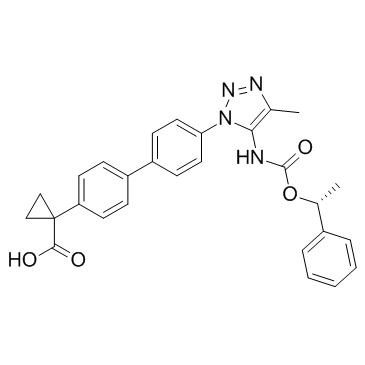1396006-71-5
| Name | Cyclopropanecarboxylic acid, 1-[4'-[4-methyl-5-[[[(1R)-1-phenylethoxy]carbonyl]amino]-1H-1,2,3-triazol-1-yl][1,1'-biphenyl]-4-yl] |
|---|
| Description | LPA1 antagonist 1 is a highly selective Lysophosphatidic Acid receptor-1 (LPA1) antagonist with an IC50 of 25 nM. |
|---|---|
| Related Catalog | |
| Target |
IC50: 25 nM (LPA1)[1]. |
| In Vitro | LPA1 antagonist 1 (compound 2) displays very potent and highly selective inhibitory activity toward LPA1, with little inhibition on LPA3 even at very high concentrations. To our knowledge, LPA1 antagonist 1 is the most selective nonlipid LPA1 antagonist so far reported. It appears that compounds (e.g., LPA1 antagonist 1) from the N-aryltriazole chemical class are much more selective for LPA1 than compounds from the corresponding pyrazole series. In comparison with Ki16425 and AM095, LPA1 antagonist 1 shows much improved antiproliferative activity. LPA1 antagonist 1 demonstrates the highest LPA1 selectivity and attenuated LPA-induced NHLF proliferation and contraction with high potency[1]. |
| In Vivo | Oral dosing of LPA1 antagonist 1 in mice causes a dose-dependent reduction in serum histamine levels induced following intravenous LPA stimulation. When mice are orally dosed with LPA1 antagonist 1 (100 mg/kg, aqueous suspension) prior to intravenous LPA injection, the LPA-induced histamine level is significantly blocked A clear PK/PD relationship is demonstrated by the correlation between the levels of LPA1 antagonist 1 and LPA-induced histamine concentrations in plasma. Although AM095 almost completely blocks histamine release (100 mg/kg), analysis of plasma samples revealed more than 65-fold higher concentrations of AM095 than LPA1 antagonist 1 (100 mg/kg). The ability of LPA1 antagonist 1 to block histamine release at much lower plasma concentration suggests that further improvement of pharmacokinetic properties of this chemical class could lower the effective dose[1]. |
| References |
| Molecular Formula | C28H26N4O4 |
|---|---|
| Molecular Weight | 482.53000 |
| Exact Mass | 482.19500 |
| PSA | 106.34000 |
| LogP | 5.74160 |
